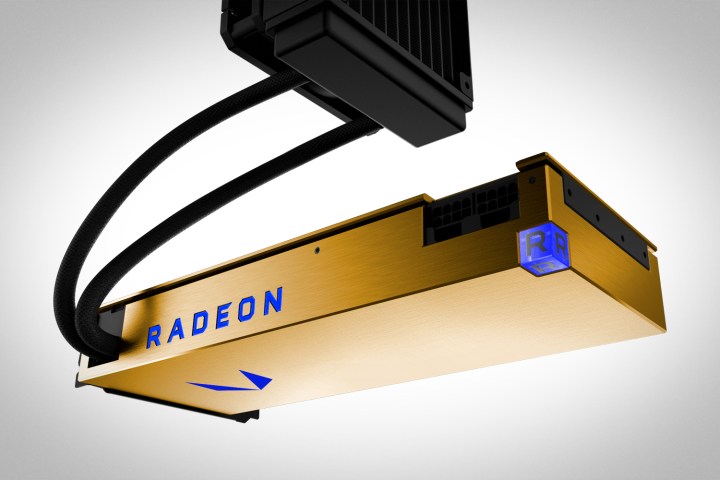
While we wait for Vega’s consumer release and the benchmarks that will accompany it, AMD’s Radeon Vega Frontier Edition stands in as a sort of proxy for guessing how Vega might perform. PC World was able to put a Vega Frontier Edition card, currently priced at $1,200, through some paces to answer some of the burning questions, and the results were rather promising.
First, it’s important to note that the Vega Frontier Edition cards are intended for workstations and not gaming machines, and for running high-end professional applications versus maximizing frame rates at reasonable prices. In this regard, PC World was able to verify that Vega Frontier Edition is a powerful option compared to Nvidia’s highest-end GeForce GTX Titan Xp.
When running a few demanding professional applications, the Vega Frontier Edition was indeed significantly faster than Nvidia’s offering. The air-cooled version of AMD’s card and the Titan Xp were both connected to Dell’s 8K display and tested in the Solidworks engineering application, Cinebench, and other tests that provide an indication of how well the cards can handle professional workloads. Vega Frontier Edition was 14 percent faster in Cinebench, 28 percent faster in Catia, and 50 percent faster in SolidWorks.
It’s not a completely apples-to-apples comparison, because Vega Frontier Edition doesn’t come with the certified drivers that highlight professional GPUs like Nvidia’s Quadro line. But as AMD pointed out, many smaller companies use consumer-level cards without certification due to their high price-performance ratios — an Nvidia Quadro that matches this level of performance would start at $2,000 for the Quadro P5000 and quickly ramp up to $6,000 for a Quadro P6000.
In terms of gaming, PC World didn’t provide any hard benchmark numbers, but attested that the Vega Frontier Edition was able to keep up with the Titan Xp in games like Doom, Prey, and Sniper Elite 4. Gaming was done with Vulcan, DirectX 11, and DirectX 12 to eliminate the gaming API as an advantage for one card over another. According to PC World, both cards were “indistinguishable” from each other during actual gameplay, or as it concluded, at least as fast as an Nvidia GTX 1080 and closer to a GTX 1080 Ti.
Anyone concerned that Vega won’t be able to hold its own against Nvidia’s fastest cards should, therefore, rest a little bit easier. Time will tell if AMD manages to push out competitive cards, but it is promising that the Vega consumer GPUs should be even faster than the Vega Frontier Edition cards for gamers. That bodes well for anyone hoping that competition will spur both faster performance and lower prices.
AmazonEditors' Recommendations
- I tested AMD’s RX 7800 XT against Nvidia’s RTX 4070, and there’s a clear winner
- AMD is letting Nvidia win, and it needs to step it up before it’s too late
- Intel Arc is finally here, and it’s cheaper than AMD and Nvidia
- Nvidia slashes the price of its RTX 2060 to $299 to battle AMD’s new RX 5600 XT



